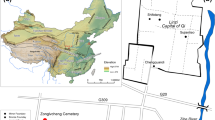Abstract
European explorers and traders, on their arrival in North America, found the aboriginal peoples willing to exchange furs and other goods for European-made metal objects and glass beads, the remains of which may be found at archaeological sites. Specific trade goods, including multi-coloured or curiously shaped glass beads that are visually distinctive, are used as chronological markers by archaeologists. Most of the single coloured, mainly blue or opaque white beads are very common and cannot be visually, chronologically differentiated. Non-destructive analysis (INAA) of turquoise blue or white beads from known-age archaeological sites in Ontario has revealed chemical changes in glass manufacturing compositions over time. This allows these otherwise nondescript, single coloured beads to be used as chronological and trade markers. Although the turquoise beads were always coloured by Cu, the white beads employed different opacifiers over time. First came Sn-rich beads (early to late 17th century); then Sb-rich beads (late 17th century to mid-19th century); finally As-rich beads (very late 18th century to early 20th century) and even F-whitened beads (19th century to 20th century). Within each major group, it appears that changes in glass making recipes may be found using the Na, K, Ca, Al and Cl contents. Therefore, chemical analysis of white glass trade beads may be as profitable as chemical analysis of turquoise blue trade beads in establishing chemical chronologies.
Similar content being viewed by others
References
K.E. Kidd and M.A. Kidd, Canadian Historic Sites: Occasional Papers in Archaeology and History, 1, 45–89 (1970).
K. Karklins, in Glass Beads, Studies in Archaeology, Architecture and History, (National Historic Parks and Sites Branch, Parks Canada, Environment Canada, 1985), p. 85.
P.P. Pratt, Oneida Iroquois Glass Trade Bead Sequence 1585-1745, (Fort Stanwix Museum, Rome, New York, 1961).
C.F. HayesIII, (editor), Proceedings of the 1982 Glass Trade Bead Conference, (Rochester Museum and Science Center, Rochester, 1983), 16.
I.T. Kenyon and T.A. Kenyon, in Proceedings of the 1982 Glass Trade Bead Conference edited by C.F. HayesIII, (Rochester Museum & Science Center, Rochester, 1983) 16, pp. 59–74.
K. Karklins, in Proceedings of the 1982 Glass Trade Bead Conference, edited by C.F. Hayes III, (Rochester Museum & Science Center, Rochester, 1983), 16, pp. 111–126.
T.L. Lewis, Neutron Activation Analysis of Glass Trade Beads, 1979 (unpublished).
R.G.V. Hancock, A. Chafe and I. Kenyon, Archaeometry 36, 253 (1994).
I. Kenyon, R.G.V. Hancock and S. Aufreiter, S. Archaeometry 37, 323 (1995).
R.G.V. Hancock, S. Aufreiter, J.-F. Moreau and I. Kenyon, in Archaeological Chemistry: Organic, Inorganic and Biochemical Analysis, edited by M.V. Orna, (American Chemical Society, Washington, 1996), pp. 23–36.
R.G.V. Hancock, J. Internat. Instit. of Conserv. - Canadian Group., 3, 21 (1978).
R.W. Douglas and S. Frank, A History of Glassmaking, (G.T. Foulis, Henley-on-Thames, 1972).
Acknowledgement
M. Latta (Department of Anthropology, University of Toronto) is thanked for her donation of all of the Auger site white glass beads. R.G.V.H. acknowledges that I. Kenyon (Ontario Heritage Foundation) gets all the credit for procuring beads from collections to which he had access, and for begging and borrowing multitudes of beads from B. Ross and C. Ds'Annibale of Parks Canada in Cornwall; from G. Warrack and L. Currie of the Ministry of Transportation in Downsview (Dewar site beads); from R. Williamson of Archaeological Services Inc. of Toronto (Orchid site beads); and from W. Ross of the Ontario Ministry of Culture, Tourism and Recreation in Thunder Bay (Dorion site beads). F. Neub (Department of Metallurgy and Materials Science, University of Toronto) let a gifted amateur use his departmental ultrasonic cleaner. p]This research was made possible by Archaeological Grant ARG-681 from the Ontario Heritage Foundation, Ontario Ministry of Culture, Tourism and Recreation to R.G.V. Hancock, and was subsidized by an Infrastructure grant to the SLOWPOKE Reactor facility from the Natural Sciences and Engineering Research Council of Canada.
Author information
Authors and Affiliations
Corresponding author
Rights and permissions
About this article
Cite this article
Hancock, R., Aufreiter, S. & Kenyon, I. European White Glass Trade Beads as Chronological and Trade Markers. MRS Online Proceedings Library 462, 181–191 (1996). https://doi.org/10.1557/PROC-462-181
Published:
Issue Date:
DOI: https://doi.org/10.1557/PROC-462-181




